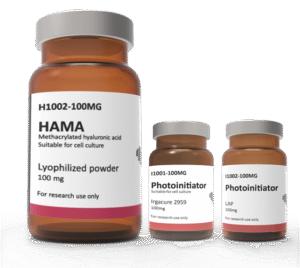Description
| Synonyms | KapMA Bioink, KapMA Lyophilizate Bioink, Methacrylated Kappa-Carrageenan Bioink, Kappa-Carrageenan Methacrylate Bioink, Kappa-Carrageenan Methacryloyl Bioink | Sterility | Sterile |
| Endotoxin level | <50 EU/mL |
| Cell viability | ≥85% mesenchymal stem cells and osteoblast cells |
| pH | 7.3 – 7.4 |
| Form | Gel |
Kappa-carrageenan bioink (KapMA) was developed by AdBioink and cell experiments were performed with the fibroblast cell NIH 3T3. Cell adhesion and encapsulation experiments of Kappa-carrageenan bioinks that photo-crosslinked in 2 different ways with UV and visible light were performed. Cell morphologies were examined on the 1st and 7th days by DAPI-Actin staining. Cells adhered to Kappa carrageenan bioinks, proliferated and were able to preserve their cell morphology. It is seen that the encapsulated cells begin to form cytoplasmic extensions on the 7th day. According to the Live/Dead staining results in which the cell viability was examined, it was seen that the cell viability was over 95% and the encapsulated cells preserved their viability for 7 days.








Reviews
There are no reviews yet.